Apple's 15-inch Core i5 MacBook Pro: The One to Get?
by Anand Lal Shimpi on April 14, 2010 10:38 PM EST- Posted in
- Mac
- MacBook Pro
- Arrandale
- Core i5
- Laptops
They’re Actually Faster
Benchmarking under OS X isn’t difficult, you just need to get creative. Luckily I’m in dire need of creative outlets so creating OS X benchmarks works for me. I’m using the same tests I introduced in my Holiday 2009 Macbook Pro roundup and running on the same hardware (specs listed in the tables on the previous pages). The Core i5 system is the new entry level 15-inch MacBook Pro.
We’ll start with general application performance.
General OS usage is a difficult thing to quantify, but one measure of performance has always been the number of bounces an icon in the dock makes before an application loads. I decided to take it to the next level and write a quick script to launch 15 applications in a row, timing how long the entire process takes.
I launched, in order: Mail, Safari, Activity Monitor, iTunes, iCal, DVD Player, iPhoto, Photo Booth, Quicktime Player, Disk Utility, Preview, iMovie, Front Row, Garage Band and Aperture.
The entire process stresses both the disk and CPU, which is why we see a huge improvement when going to an SSD as well as differences between CPU speeds.
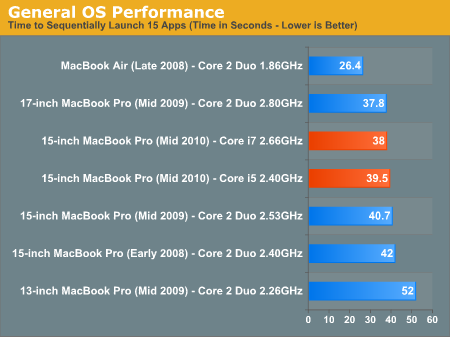
My application launch test absolutely rocks on the MacBook Air because it ships with an SSD by default. The MacBook Pros are stuck with mechanical hard drives and thus don’t perform nearly as well. If you’re curious, installing an Intel X25-M G2 in any of the MBPs will drop their times to 16 seconds or less.
The new MacBook Pro also doesn’t improve performance that much. I measured a 3% increase in performance, which although repeatable, isn’t really spectacular. This is compared to the old 2.53GHz Core 2 Duo and should serve as a baseline for the minimum performance improvement you should see. In other words, the 2.4GHz 15-inch MacBook Pro should perform no worse than last year’s 2.53GHz model.
The $2199 model with a Core i7 running at 2.66GHz pushes performance up another 3.9% over the base model. That's actually more than I expected but the real strength of the i7 is visible in the more CPU bound tests.
Adobe Photoshop CS4 Performance
The Retouch Artists Speed Test we use for our CPU testing under Windows also works under OS X. We're running the exact same benchmark here, basically performing a bunch of image manipulations and filters and timing the entire process.
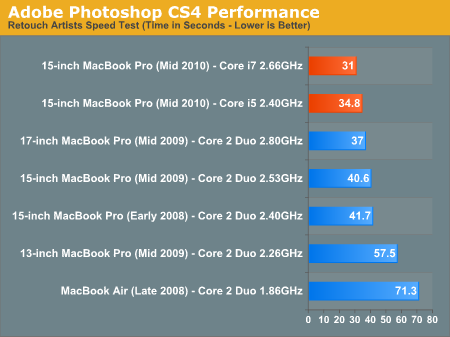
The old 13-inch MacBook Pro is penalized by only shipping with 2GB of memory, which is why it performs so poorly here. The real comparison is between the 2.4GHz Core i5 vs. the 2.53GHz Core 2 Duo from last year. The former is 16.6% faster in our Photoshop test. In fact, the new 15-inch MacBook Pro is even faster than the older 2.80GHz 17-inch model I reviewed.
The Core i7 model is 12.3% faster than the baseline Core i5 2.40GHz. Definitely noticeable.
Aperture 2 RAW Import
For my Aperture test I simply timed how long it took to import 203 12MP RAW images into the library.
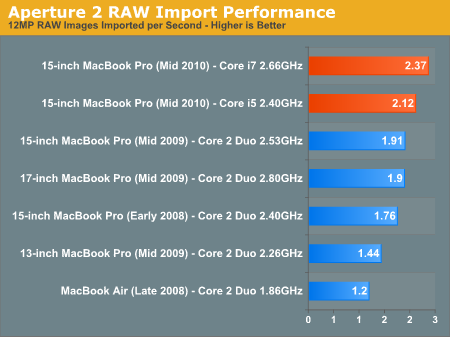
The new entry level 15-inch MBP is 10.9% faster than the old MacBook Pro, and again, it’s faster than the old 17-inch model as well. Moving to the Core i7 gives you another 11.8%.
Cinebench R10
I’m a fan of the Cinebench test because it lets me show off both single and multithreaded performance in the same workload. First, the single threaded performance:
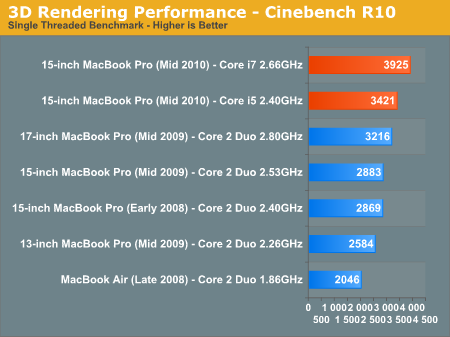
Here we have a huge advantage on the new MacBook Pro. Intel’s Turbo Boost is active here, resulting in a large performance advantage, not to mention all of the enhancements present in the Nehalem/Arrandale architectures. This is one of the best situations for the Core i7 vs. the i5. The extra $400 gives you another 14.7%, not bad at all.
Multithreaded performance is equally impressive:
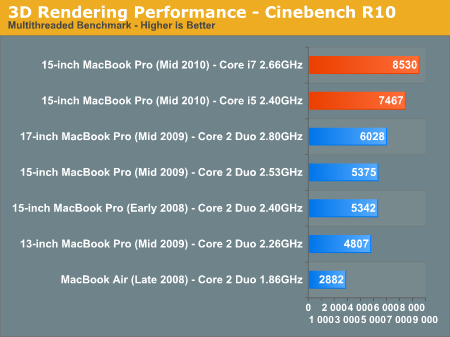
Thanks to Hyper Threading, the new Core i5 puts a generational gap between itself and last year’s MacBook Pro in this test. Whether you’re running single threaded or multithreaded applications, the Core i5 can be noticeably faster than the Core 2 Duo.
Quicktime H.264 Video Encoding
Our final benchmark is more consumer focused. Here I'm taking an XviD and converting it to an iPhone-supported H.264 format.
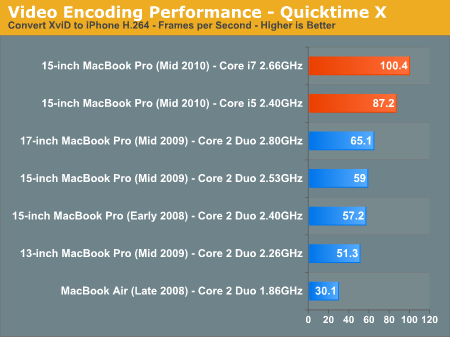
Video encoding is one of the i5’s definite strengths. If you do a lot of video encoding on your notebook, the jump from Core 2 to i5 is tremendous - approaching 50% in this case even despite the “lower” default clock speed. This is also the best showing for the Core i7 - count on an extra 15% over the base Core i5.
Core i7 vs. Core i5 Performance Summary
The two Core i5 models Apple offers ship with a 2.40GHz or 2.53GHz processor, both with a 3MB L3 cache. The $2199 15-inch MacBook Pro comes with a 2.66GHz Core i7, with a full 4MB L3 cache. Compared to the entry level model that's an 11% increase in clock speed and a 33% increase in L3 cache.
While I don't believe there's much reason to go for the 2.53GHz over the 2.40GHz model (L3 cache size remains the same, clock speed goes up by a small amount), the Core i7 is actually pretty decent. For a 22% increase in total system cost you end up with 11 - 15% better performance in CPU bound applications. It actually even feels snappier in general use as well.
I'd still suggest opting for an SSD before considering any CPU upgrades, but if you're looking to keep your new MacBook Pro for a while the Core i7 is worth it.










114 Comments
View All Comments
n0dder - Friday, April 16, 2010 - link
Would you say that the increased working temperatures in the new MacBooks prohibits its use as a real Laptop? I'm currently using a rev 2.1 MacBook (2.16GHz), and spend 3-6 hours with it in my lap every day, and while it gets too hot if I stress it, surfing the web and doing light work is fine - if the new MBP's run hotter than that, I guess that I shouldn't have waited this long, but have gone for the previous model.TIA,
Terry1 - Saturday, April 17, 2010 - link
On page 5 of Anand's review, he notes that OS10 manages the switching between imbedded graphics and the Nvidia board. No user control apparently provided. Question: what happens when you are running bootcamp with Windows 7 as second operating system? Is OS10 lurking in the background to keep this process functioning, or (my concern) does the system just default to the imbedded GPU mode?Terry1 - Saturday, April 17, 2010 - link
RE my prior post it looks like I missed this comment in the review: "Despite using a NVIDIA GPU, there's no support for Optimus under Windows 7 on the new MacBook Pro. The GeForce GT 330M is always in use there regardless of whether you use an Optimus enabled driver or the 196.21 driver that comes with the MacBook Pro." That's the way I would want it given manual control is impossible, but has this been verified by a user/tester?PubicTheHare - Sunday, April 18, 2010 - link
Anand said to wait until the next revision of Arrandale if we want cooler laptops."Next revision of..." meaning these new MBPs are Arrandale?
If they are (I'm assuming Arrandale is 32 nm), then what would the next revision bring to equate to cooler machines?
I'm disappointed in the heat issue. My Santa Rosa MBP (early 2008) runs hot as hell, especially when I watch YouTube but even if I'm not running video or flash. It bugs me.
I won't upgrade until:
1) OS X supports TRIM (so I can throw in a Crucial C300 SSD or higher capacity Intel G2)
2) USB 3.0 or Lightpeak is available on the MBP
3) The laptops run cooler with discrete graphics
I was really hoping to upgrade this time...
BillyboyPC - Tuesday, April 20, 2010 - link
These MacBooks will be perfect with more affordable SSDs and USB 3. Until then, it's still a no-go for me.R0N1 - Wednesday, April 21, 2010 - link
Great article, but at least one aspect not mentioned:All the Arrandale chips mentioned are the standard voltage M version with 35W TDP. True, this TDP also includes integrated GPU, but still: 35W is a lot for a laptop.
The 18W 640UM, 620Um & 540UM are probably "reserved" for new MacBook Air,
But it would surly be beneficial for MBP to use the 25W LV parts (current lineup lists i7 620LM & 640LM) - any chance Apple would consider using them in MBP?
After all, all the Penryn P series CPUs are medium voltage 25W TDP chips, compared to cheaper (per MHz) T series standard voltage 35W ones.
The new Arrandale revision you mentioned - is this really silicon respin supposed to trim excessive power from the standard voltage M chips, just production process improvement or merely chip binning?
Thanks.
jvin85 - Friday, May 7, 2010 - link
Anand Lal Shimpi,I didn't see any mention about the memory difference for the Geforce GT 330M. I was wondering what differences the extra 256MB makes.
I'm considering upgrading as I use an early 2008 MBP. Back then going for the better graphics card was always a big debate. I am wondering if it truly makes a difference in these models.
Thanks.
Kathi - Wednesday, August 18, 2010 - link
I am thinking about bying a 13″ because I like the size and it would be perfekt for me. But I prefer the new i5 processor. Do you think there is a chance that there will come a new 13″ with the i5 processor? Soon? I don´t want to wait too long, but it would be stupid if a new version comes out just after I bought one…xxunrealdudexx - Friday, August 20, 2010 - link
Heading off to Uni in the fall but can't decide between 13" or 15". Which should I get? I'm in the BBA program so I don't think ill be needing Photoshop/Final Cut/etc.?? And I would like it to last for the full 4 years at least. Thanks guys!juhku - Friday, September 3, 2010 - link
Great article! Thanks!Any new information about Arrandale update to get the MacBook run cooler? Is it happening and when?